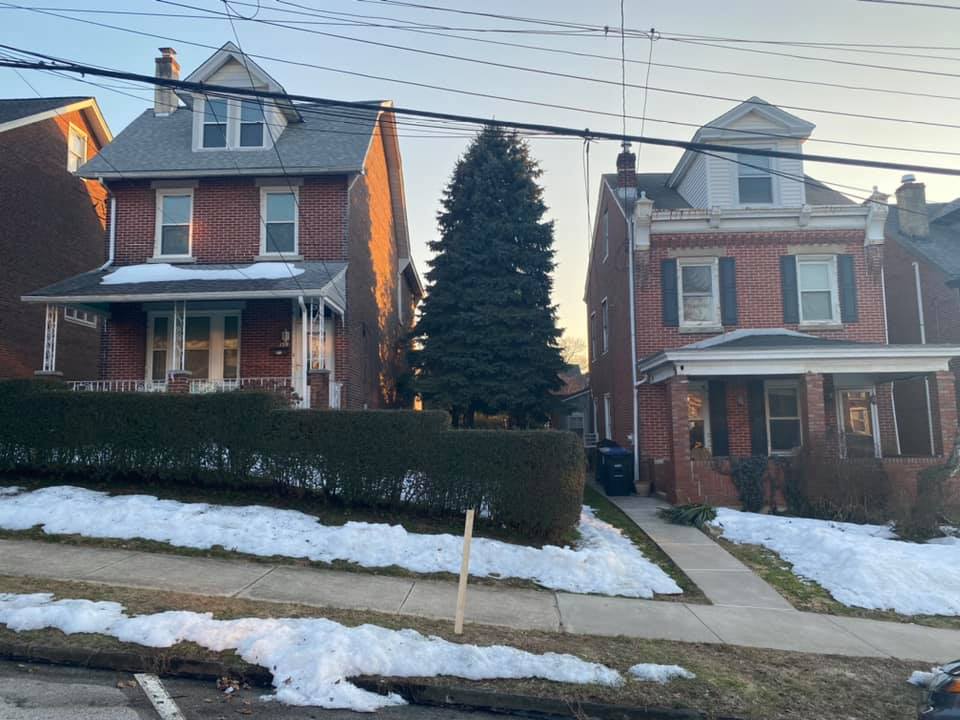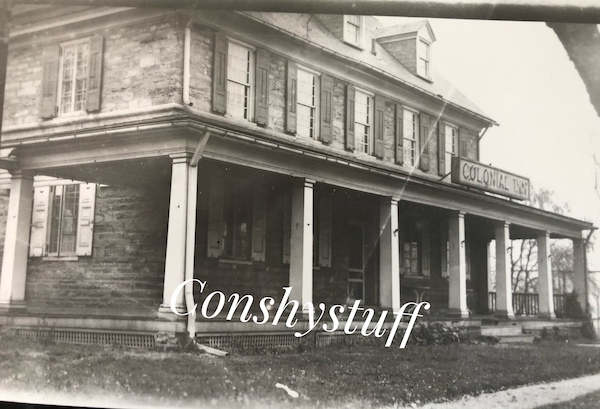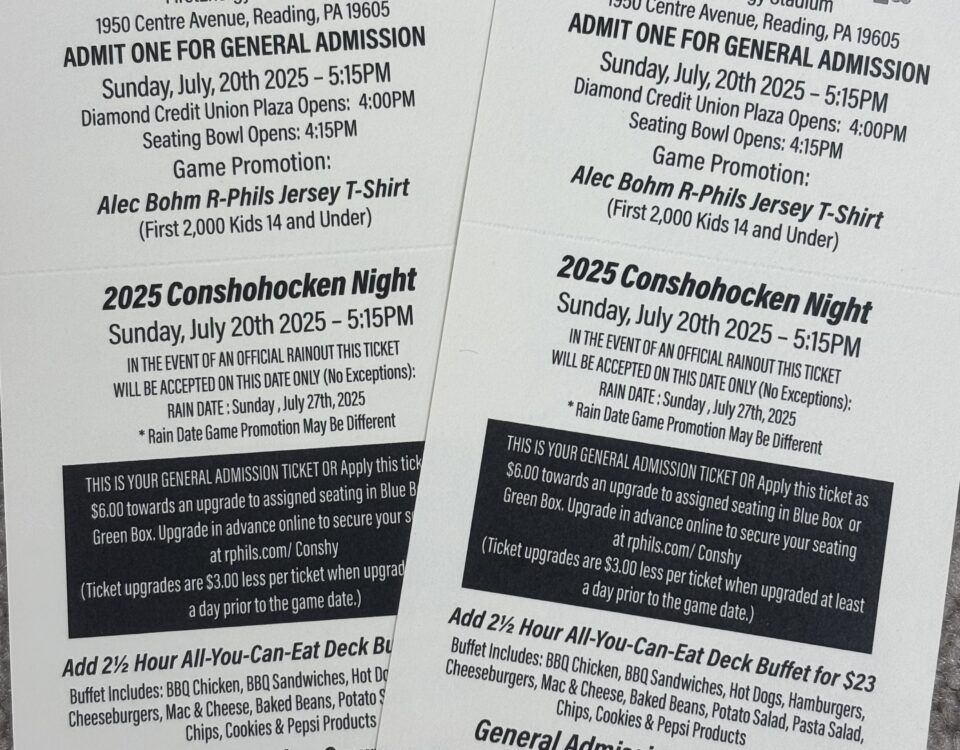
Home Experts for You, Charity Raffle for the CNC
February 28, 2021
Cell Phone Tower on West 3rd?
March 4, 2021Prohibition – A Little Education and Conshohocken’s Involvement

Prohibition
A little Education
And Conshohocken’s Involvement
By Jack Coll
2-18-21
Well it happened one hundred and one years ago this month, prohibition. I’ve always had an interest in prohibition but I must confess I’m certainly no authority on the subject. To understand prohibition you have to understand what led up-to the ratification of the 18th Amendment by legislatures back in 1919 to ban the manufacture, sale and transportation of intoxicating liquors.

The Prohibition movement actually started in the 1800’s with the formation of the Women’s Christian Temperance Union (WCTU) founded in Cleveland Ohio in 1874, the WCTU soon became the largest women’s organization in the country including a chapter in Conshohocken. The Conshohocken chapter built their headquarters on the northwest corner of Third Avenue and Forrest Street, the building still stands and while it has served as everything from a church to a furniture shop over the years it is currently an office building. Through education and example the WCTU hoped to obtain pledges of total abstinence from alcohol.
To understand the concerns and formation of the WCTU we have to go back in time a hundred and fifty years to a time when most houses were simply wooden shacks with a fire-place and or a hot-stove in the room. Out-houses were used by every building in the country, Women were objects who made meals and scrubbed laundry by hand. Females at the time were strictly and simply second rate citizens with very few rights. Females were not permitted to vote or smoke cigarettes and rape, married or unmarried wasn’t illegal.
In contrast men lived under different rules and different laws. Young men worked the steel mills, the quarries, the foundries and the textile mills 50-60-70 hours a week. At the end of their work-day or work-week they didn’t get to relax with kicking their feet up and watching a good game on the television or travel to the mall and they certainly didn’t make enough money to go golfing. Their outlets were the local bars and saloons. Many of the bars carried the name “Hotel” at the turn of the century.
Years before many of these bars and saloons allowed females and before the bars added “Female Entrances” to the side or back of the drinking establishment’s alcohol consumption was mostly a men’s activity, inside these drinking establishments it was “a man’s world.” This men only activity all too often, the result was serious physical, financial and emotional harm for women. These abuses led to a growing belief for the need of legal protections.
The 18th Amendment was ratified in 1919 and on January 16, 1920, the Amendment went into effect. Now there’s a couple of things I find somewhat suspicious, For starters the 18th Amendment was ratified in 1919 to the Federal Constitution and yet the Amendment didn’t go into effect until a year later, allowing residents and establishments to stash away liquors for their personal consumption. Remember it wasn’t illegal to drink alcohol during prohibition, however it was illegal to manufacture, sell or transport the liquor and alcohol. While most citizens were able to stash a few bottles of liquor in their cabinets it was reported that the more affluent drinkers built cavernous wine cellars and even bought out whole liquor store inventories to ensure they had healthy stockpiles of legal hooch.
Another interesting fact was the Volstead Act included a few interesting exceptions to the ban on distributing alcohol. Sacramental wine was still permitted for religious purposes (the number of questionable rabbis and priests soon skyrocketed), and drug stores were allowed to sell “Medicinal whiskey” to treat everything from toothaches to the flu. With a physician’s prescription, “patients” could legally buy a pint of hard liquor every ten days. This pharmaceutical booze often came with seemingly laughable doctor’s orders such as “Take three ounces every hour for stimulant until stimulated.”
Many speakeasies eventually operated under the guise of being pharmacies, and legitimate chains flourished. According to Prohibition historian Daniel Okrent, windfalls from legal alcohol sales helped the drug store chain Walgreens grow from around 20 locations to more than 500 during the 1920’s.
By the late 1920’s, Americans were spending more money than ever on black market booze. New York City boasted more than 30,000 speakeasies. (In 2019 New York City had 23,000 restaurants) Detroit’s alcohol trade was second only to the auto industry in its contribution to the economy. With the country bogged down by the Great Depression, anti-Prohibition activists argued that potential savings and tax revenue from alcohol were too precious to ignore. The Public agreed. After Franklin E. Roosevelt called for repeal during the 1932 presidential campaign, he won the election in a landslide. Prohibition was dead a year later, when a majority of states ratified the 21st Amendment repealing the 18th.
While many small distilleries and breweries continued to operate in secret during Prohibition, the rest had to either shut their doors or find new uses for their factories. Yuengling and Anheuser Busch both refitted their breweries to make ice cream, while Coors doubled down on the production of pottery and ceramics. Others produced “near beer”-legal brew that contained less than 0.5 percent alcohol. The lion’s share of brewers kept the lights on by peddling malt syrup, a legally dubious extract that could be easily made into beer by adding water and yeast and allowing time for fermentation. Winemakers followed a similar route by selling chunks of grape concentrate called “wine bricks.”
MEANWHILE IN CONSHOHOCKEN!
By 1920 Conshohocken and West Conshohocken was a full-blown drinking man’s towns. Alan Wood Steel Company had more than 5,000 employees while other industries like Lee Tire & Rubber Company, Walker Brothers, Schuylkill Iron Works, Quaker Chemical, Reilly Whitman, Hale Pumps and many others including a number of textile mills provided thousands of more jobs and just about every working man in both boroughs would always stop for a couple to wash the steel dust and other chemicals out of their throats at one of the borough’s more than two dozen drinking establishments.

When the 18th Amendment was pressed into law most of the boroughs watering holes were shut down like the Hotel Montgomery, the Keystone Hotel and the Mansion House in Connaughtown, many of these bars reopened as speakeasies.
McLaughlin’s Bar in West Conshohocken kept the doors open with an ice cream counter as did Brady’s Bar at 123 Fayette Street. Many of the local bars simply became speakeasies with private memberships and opened themselves up to being raided by local and federal officials.
During the nearly 13 years of prohibition Conshohocken and West Conshohocken at times looked like a movie set with kegs of moonshine sitting on the sidewalk with federal agents swinging axes and gallons of hooch running down the gutters of the streets and avenues of the boroughs.
In Conshohocken and West Conshohocken, “speakeasies” and other underground drinking establishments flourished throughout the boroughs. There were also hundreds of private drinking bars. On Saturday nights, Ford Street in West Conshohocken looked like a tourist town with all the visitors coming and going. In Conshohocken, Hector Street, Elm Street, Lower Maple Street and all of Connaughtown seemed to have more visitors then residents.
AND SO IT BEGAN:
The very first raid and arrest in Conshohocken came on a Tuesday, August 24, 1922 when five local men and one woman were arrested for violation of the prohibition laws. The warrants were issued for James P. Scanlin, of the East End Hotel; John A. Harrold, of the Hotel Harrold; Daniel J. Hoey, of the Forest House Hotel; James Rath, of the St. Clair House and James McGuire of West Conshohocken. The warrants were served upon all the hotelman named, with the exception of Daniel Hoey, who had been spending the summer at Wildwood N.J., and the Warrant against him was withdrawn and one issued for the arrest of his wife.

This was the first of many, many raids that would be executed in the boroughs over the next decade. While we don’t have the space to tell all the stories we plucked a few interesting articles from the old Conshohocken Recorder newspaper from the prohibition era and listed them randomly below. I’ve listed the date and the headline, I’ve abbreviated many of the articles in the interest of space. I have also deleted many of the names from the articles as I felt relatives just might still be living in the area and I’m not sure how they would feel about seeing a grandfather or great grandfather’s name associated with the term “Bootlegger.” In the articles I’ve substituted the names with the name JOE BLOW in caps and bold letters. I will print names not familiar and out-of-town names.
I have hundreds of articles about local and federal busts in the twin boroughs so what-da-ya say we start with this one:
March 6, 1923
WOMAN RUN STILL AS HUSBAND WORKED
Police Raided Kerstosak Home Friday Afternoon and found
Still in Operation in Charge of Wife
HELD UNDER $1000 BAIL
Another successful raid was made in this borough on Friday afternoon when State Policemen Brady and Strouchbach and Officers Heald and Ruth, of the local police force searched the premises of Stanislaw Kerstosak, known as the “Soap House,” at Seventh Avenue and Jones Street, and there found a still in operation, four barrels of mash and two gallons of alcohol. The still and alcohol were confiscated and the mash was destroyed.
When the officers arrived Kerstosak was not at home but his wife Sophia was present. As soon as she saw the officers she immediately destroyed a gallon of liquor by pouring it into a barrel of flour. The raiding party however went to a stable in which was fitted up a room as a distillery an there found a four gallon still in operation. They also secured a quantity of liquor and four barrels of mash.
Kerstosak was at work at the Lee Tire Plant at the time and his wife refused to divulge his whereabouts and the officers simply took the woman into custody.
(The home of Kerstosak was formerly used as an office for the brick yard which operated on Spring Mill Avenue back before the turn of the century. Later the building was used as a soap factory and when Kerstosak purchased it he made a number of repairs and placed the building in first-class condition. In addition to the house he also owned seven lots of land adjoining.)
April 10, 1928
SHOEMAKER HELD ON LIQUOR CHARGE
Constable and Police Raid Elm Street Store Upon Complaint of Selling Whiskey
Woman Tries to Destroy Evidence
The place of business of Benny Zubraski, who conducts a shoe repair shop and boarding house at 20 West Elm Street, was raided by Constable John Smith of West Conshohocken, and the local police on Saturday night and a small quantity of whiskey confiscated.
The proprietor was placed under $2,500 bail on Sunday by Magistrate White for a hearing tomorrow. When Chief Heald and members of the police force went to the Zubraski home to make a search and arrest they witnessed Zubraski’s wife throwing a pint bottle down the cellar steps. Constable Smith rushed down the steps and while the bottle was broken, he succeeded in getting about one-half pint of the contents. In addition to this the officers got a full one-half pint bottle and a gallon container containing more than a pint of alleged whiskey. The alleged whiskey was turned over to the District attorney’s office for analysis.
Ya gotta love this one:
January 25, 1924
POLICE STOP MOTORS TO SEARCH FOR RUM
Undertaker, Bringing A Body Here, Stopped By State Police
Who Followed Motor Until Corpse Was Removed.
Challenged Police
All undertakers look alike to the new highway State Patrol, and rum will not be transported as dead bodies while they are on the job.
Undertaker Moore yesterday morning transported a corpse from Philadelphia to his morgue here. The motor car was in charge of Michael Moore Jr. and he was driving on the Ridge Pike in Roxborough, motor patrolman stopped his car and demanded to know what was in the basket in the “dead” car. They were informed the basket contained a corpse. Moore was permitted to proceed on his way after telling his destination. A patrolman in a bandit chasing car ran ahead of the Moore car and arrived here with it.
At the morgue the basket was removed from the car and the patrolman to make sure that the Volstead act was not being violated went in to the morgue and saw the basket opened and was satisfied that there had been no attempt at rum running when he gazed upon a corpse.
February 18, 1924
EASY TO GET LIQUOR HERE, TELLS COURT
Mrs. James Miller Blames Ease to Get “Hootch”
As Cause of Husband’s Neglect of Family—Others Sentences
MRS. JOE BLOW of this borough testified before Judge Solly that in domestic relations court, Saturday, she couldn’t keep her husband from getting alcoholic liquor. She said, “Every other house in Conshohocken is a “hootch” house.
MRS. BLOW stated that in her eighteen years of married life she has been tormented and abused by her husband JOE BLOW, when he was drunk, in which condition he was a great part of the time. He lost one good position after another for this reason. About two weeks ago he came to his home violently drunk and smashed up the furniture. As the outcome of this outbreak MRS. BLOW had him arrested.
MR. BLOW told Judge Solly that all his wife had said about their married life is true. He promised Judge Solly that he would not drink anymore.
August 4, 1922
FREQUENT DRUNKS LEADS TO RAID
Constables Raid Elm Street Store and Find Hootch and a Barrel of Raisin Wine
The ease with which liquor can be secured and the frequency of getting drunk by a number of North End men caused agitation on the part of suffering wives to have the source of liquor supply stopped and complaint was made that caused Norristown constables to raid the grocery store and home of Peter Tonnassoni, Elm and Corson Streets Wednesday afternoon.
The raid was made by constables Robert Porter, Norristown and Milton Rumsey, Whitemarsh and Detective Charles Haines. The officers found a barrel of raisin wine and also a quantity of hootch.
The police took samples of the wine and hootch and made the balance unfit for drinking. The raid was quietly conducted but attracted the attention of many residents of the neighborhood who gathered to see the prisoners taken away.
It is an open secret about town that a big illicit liquor traffic is being carried out in the North End and along Maple Street. Recently residents were disturbed by the actions of several boys who were drunk on hootch and they openly declared they secured wine on Maple Street at $1 a quart.
For the sake-of-space we’ll just run a few more headlines:
March 30, 1923
WEST SIDE RAID NETS 75 GALLONS LIQUORS
State Police confiscate Big Stock at Matsonford Hotel,
West Conshohocken on Wednesday
The biggest and most valuable haul of the many liquor raids made by State Police in this district was at the Matsonford Hotel on Ford Street in West Conshohocken.
January 3, 1928
RAID WEST SIDE STORE AS SPEAKEASY
Peter McGuire Caught in County Clean-Up
The store of Peter Maguire, 937 Ford Street, West Conshohocken was raided by county detective Stevenson and a detail of State Police shortly after nine o’clock Saturday evening and according to the officers about five gallons of alleged whiskey confiscated.
December 2, 1930
POLICE RAID MCGUIRE PLACE; SEIZE LIQUOR
Find Patrons in Place and No One in Attendance
RIP OUT FIXTURES
Warrant Issued for Thomas McGuire, Who Escaped Raiders
State Police, in charge Sergeant Hughes, raided the store operated by Thomas McGuire, in Elm Street near Forrest Street, at 8:45 Saturday evening, as an alleged speak easy. The police gained entrance by forcing the front entrance and entering the building found several men in a back room arraigned as a bar room. On the bar was standing two glasses containing alleged beer. No one was behind the bar and all the men denied having any connection with the place. When questioned as to who placed the glasses on the bar, the police were informed they were placed by Thomas McGuire, owner of the building and alleged to be the proprietor of the place.
February 18, 1924
MOORE ACQUITTED OF GAMBLING AND LIQUOR SELLING
Jury Returned Verdict at Noon Today—Costs on Defendant on Liquor Charge
Before Judge Solly in Court Room No 3 was taken up the case of Ellsworth Moore, proprietor of the Mansion House on Old Elm Street, Conshohocken, charged with selling liquor.
Two investigators from a Philadelphia detective agency testified to buying liquor at Moore’s garage last October. The detectives said that they were employed by the Allan Wood Iron and Steel Company, Conshohocken. The place was raided by the State Police on December 28th and no intoxicating liquor was found.
The defendant denied of ever having any intoxicating liquor in his place or ever having sold any to anyone or ever having seen the two detectives who claimed in their testimony of having been every friendly with him during their two days stay in Conshohocken.
At noon today a jury returned a verdict of not guilty of keeping a gambling house and placed the costs on the county. The jury also returned a verdict of not guilty on the charge of selling intoxicating liquors and placed the cost on the defendant.
June 10, 1930
RAID, BLOCKS STREET TRAFFIC
State and County Officers Make Usual Friday Night Raid Here.
Arrest John Whalen and Two Others at Fayette St. Place

The most spectacular of the many raids that have been staged in this borough since the days of prohibition was the one staged on Friday night when State and County Police raided the place of John Whalen at 29 Fayette Street, confiscated a quantity of alleged high powered beer, two slot machines and arrested Whalen, the alleged proprietor George Carlin, of East Third Avenue, alleged bartender and George Stemple of Spring Mill Avenue who is charged as a “Lookout.” All were taken before Magistrate Isaac Kehoe of Norristown and placed under bail.
Throughout the “Roaring 20’s” it was reported that hundreds of illegal speak-easy’s” existed in both Conshohocken and West Conshohocken, (As well as in Plymouth and Whitemarsh). In every edition of the Conshohocken Recorder newspaper for all of the years of prohibition there were two-three and four articles of local speak-easy’s getting busted, the paper was published twice a week back then.
I’ve always enjoyed reading about how Conshohocken had mob run establishments, illegal gambling halls and speak-easy’s here a hundred years ago. It really was quite an era to live-in. Perhaps on another winter’s day, when I’m sitting in my office on a Sunday afternoon listening to my 60’s music, I’ll pull out the Prohibition files and share a few more stories on the speak-easy raids up and down the avenues or write an article on the borough’s gambling halls. As I mentioned earlier in the article Connaughtown, Maple Street, Elm and Hector Streets were loaded with stills that ran day and night. For the record the illegal hootch was known as “Moonshine.” Moonshine got its name because the hootch was made mostly at night by the light of the moon. The term “Sunshine” was often used when housewives were busted for mixing “Shine” in bathtubs primarily after their husbands left for work for the day. The Shine was mixed during the day when the feds weren’t likely to be searching for the home-made brew.

Conshohocken has a history, all kinds of history, I wonder how we’ll be viewed a hundred years from now in the year 2121, interesting thought. I wonder if history will show things like home-made illegal vaccine for the covid-pandemic was running rampant throughout the borough. I wonder if we’ll be reading the names of residents who hoarded toilet-paper or stocked up on beer and whiskey in hopes of making money in the black market once all the liquor stores were ordered closed.
I think that the year 2020-2021 will be remembered in Conshohocken for the residents and the small businesses who were more than happy and proud to help our neighbors who struggled to make ends meet.
Wouldn’t that be nice.
Photographs shown above in this article include:
The Mansion House located on Old Elm Street in Connaughtown, it was no surprise the Mansion House was a speakeasy due to its location, just across the street from the Alan Wood Steel Company the main route for the steel workers to travel home from work every day. There was a time when the Mansion House was a jumpin’-hip establishment with live music and dancing every Friday and Saturday night.
What most of us would know as the Brown Derby, or The Great American Pub today, well back in the 1930’s it was Brady’s Bar at 123 Fayette Street and Mr. Brady turned his bar into an ice-cream and malt shop much to the delight of his children.
The Montgomery House was located just off the Matsonford Bridge at the corner of Fayette and Marble Streets. The Montgomery House was later renamed “The Musical Bar” but in the 1930’s it was not only a speakeasy, but a gambling hall as well. Most of the illegal hootch was distributed on the second floor while allthe gambling took place on the third floor. Dice games, slot machines, card games and heavy betting on every game of pool that was played. The building was demolished as part of the urban redevelopment project in the 1970’s.
Scanlin’s Hotel once located at the corner of Hector and Jones Street was a popular place to get your “Shine” back in the 1920’s. Scanlin’s Hotel was the target of federal agents on many occasions during the prohibition era.
The Colonial Inn once located on North Lane, the former Legaux Mansion and country club was a different kind of “speakeasy.” Serving some of the best Moonshine on the market, membership to the Colonial Inn was a must. It was reported back in the day that this is where Judges from Montgomery County and throughout the Philadelphia area would spend their Friday and Saturday nights with wives, girlfriends and mistresses. Lawyers and prominent doctors were among the elite members to hold a membership card to the Colonial Inn. There are no records of any raids, bust or arrest at the Colonial Inn during the prohibition era. I’ve often wondered why?

During Covid, we should all sneak into a local Pub, pull a stool up to the bar and order a cold-one, for a moment while sipping a beer at the bar, we could look around to see if the Governor is watching, and you’ll know exactly what it felt like sneaking into a speakeasy back in the day. Enjoy that beer!

